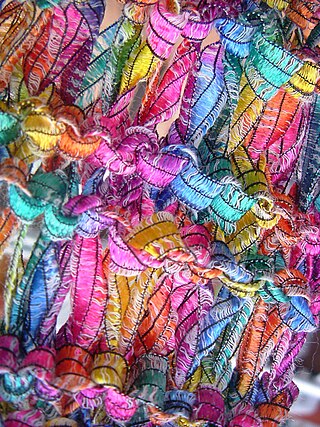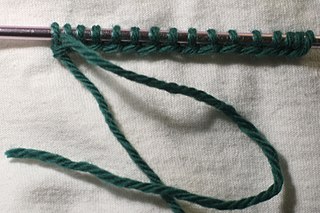
Crochet is a process of creating textiles by using a crochet hook to interlock loops of yarn, thread, or strands of other materials. The name is derived from the French term crochet, which means 'hook'. Hooks can be made from different materials, sizes, and types. The key difference between crochet and knitting, beyond the implements used for their production, is that each stitch in crochet is completed before you begin the next one, while knitting keeps many stitches open at a time. Some variant forms of crochet, such as Tunisian crochet and Broomstick lace, do keep multiple crochet stitches open at a time.

Knitting is a method for production of textile fabrics by interlacing yarn loops with loops of the same or other yarns. It is used to create many types of garments. Knitting may be done by hand or by machine.

Tatting is a technique for handcrafting a particularly durable lace from a series of knots and loops. Tatting can be used to make lace edging as well as doilies, collars, accessories such as earrings, necklaces, waist beads, and other decorative pieces. The lace is formed by a pattern of rings and chains formed from a series of cow hitch or half-hitch knots, called double stitches, over a core thread. Gaps can be left between the stitches to form picots, which are used for practical construction as well as decorative effect.

Tunisian crochet or Afghan crochet is a type of crochet that uses an elongated hook, often with a stopper on the handle end, called an Afghan hook. It is sometimes considered to be a mixture of crocheting and knitting. As such, some techniques used in knitting are also applicable in Tunisian crochet. One example is the intarsia method.

A knitting needle or knitting pin is a tool in hand-knitting to produce knitted fabrics. They generally have a long shaft and taper at their end, but they are not nearly as sharp as sewing needles. Their purpose is two-fold. The long shaft holds the active (unsecured) stitches of the fabric, to prevent them from unravelling, whereas the tapered ends are used to form new stitches. Most commonly, a new stitch is formed by inserting the tapered end through an active stitch, catching a loop of fresh yarn and drawing it through the stitch; this secures the initial stitch and forms a new active stitch in its place. In specialized forms of knitting the needle may be passed between active stitches being held on another needle, or indeed between/through inactive stitches that have been knit previously.
A crochet hook is an implement used to make loops in thread or yarn and to interlock them into crochet stitches. It is a round shaft pointed on one end, with a lateral groove behind it. The point eases the insertion of the hook through the material being crocheted and the groove makes it possible to pull a loop back through the material. The shaft is then divided into a working area that determines the hook's nominal diameter and ensures the uniform sizing of the loops formed on it, and a handle.

Nålebinding is a fabric creation technique predating both knitting and crochet. Also known in English as "knotless netting", "knotless knitting", or "single-needle knitting", the technique is distinct from crochet in that it involves passing the full length of the working thread through each loop, unlike crochet where the work is formed only of loops, never involving the free end. It also differs from knitting in that lengths must be pieced together during the process of nålebinding, rather than a continuous strand of yarn that can easily be pulled out. Archaeological specimens of fabric made by nålebinding can be difficult to distinguish from knitted fabric.

Darning is a sewing technique for repairing holes or worn areas in fabric or knitting using needle and thread alone. It is often done by hand, but using a sewing machine is also possible. Hand darning employs the darning stitch, a simple running stitch in which the thread is "woven" in rows along the grain of the fabric, with the stitcher reversing direction at the end of each row, and then filling in the framework thus created, as if weaving. Darning is a traditional method for repairing fabric damage or holes that do not run along a seam, and where patching is impractical or would create discomfort for the wearer, such as on the heel of a sock.
Combined knitting or combination knitting is a knitting method that combines elements of Eastern-style knitting with the Western techniques. The name was suggested by Mary Thomas in her 1938 book "Mary Thomas's Knitting Book", where she described the method as "..the better way to work in Flat Knitting. The resulting fabric is more even and closer in construction." By wrapping the yarn the opposite way while purling, the knitter changes the orientation of the resulting loops; then the next row's knit stitches can be formed by inserting the needle through the back leg, rather than through the front leg, without twisting the stitch. This method is suitable for all knitted fabrics from the basic Stockinette stitch, to any other technique, such as Fair Isle, circular knitting, or lace knitting.

Hairpin lace is a lace-making technique that uses a crochet hook and two parallel metal rods held at the top and the bottom by removable bars. Historically, a metal U-shaped eponymous hairpin was used.

A knitting machine is a device used to create knitted fabrics in a semi or fully automated fashion. There are numerous types of knitting machines, ranging from simple spool or board templates with no moving parts to highly complex mechanisms controlled by electronics. All, however, produce various types of knitted fabrics, usually either flat or tubular, and of varying degrees of complexity. Pattern stitches can be selected by hand manipulation of the needles, push-buttons and dials, mechanical punch cards, or electronic pattern reading devices and computers.

In knitting, an increase is the creation of one or more new stitches, which may be done by various methods that create distinctive effects in the fabric. Most knitting increases either lean towards the left or the right.

Drop-stitch knitting is a knitting technique for producing open, vertical stripes in a garment. The basic idea is to knit a solid fabric, then (deliberately) drop one or more stitches, producing a run in the fabric. The run will continue to the bottom edge of the garment, or until it encounters an increase, at which it stops.

In knitting, casting on is a family of techniques for adding new stitches that do not depend on earlier stitches, i.e., having an independent lower edge. In principle, it is the opposite of binding off, but the techniques involved are generally unrelated.
Knitting abbreviations are often used for brevity in describing knitting patterns.
In knitting, a plaited stitch, also known as a twisted stitch, is a single knitted stitch that is twisted clockwise or counterclockwise, usually by one half-turn (180°) but sometimes by a full turn (360°) or more.

Knitted fabric is a textile that results from knitting, the process of inter-looping of yarns or inter-meshing of loops. Its properties are distinct from woven fabric in that it is more flexible and can be more readily constructed into smaller pieces, making it ideal for socks and hats.

A picot is a loop of thread created for functional or ornamental purposes along the edge of lace or ribbon, or crocheted, knitted or tatted fabric. The loops vary in size according to their function and artistic intention.
Hand knitting is a form of knitting, in which the knitted fabric is produced by hand using needles.

In the textile arts, a stitch is a single turn or loop of thread, or yarn. Stitches are the fundamental elements of sewing, knitting, embroidery, crochet, and needle lace-making, whether by hand or machine. A variety of stitches, each with one or more names, are used for specific purposes.

















